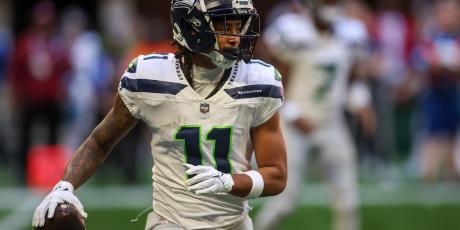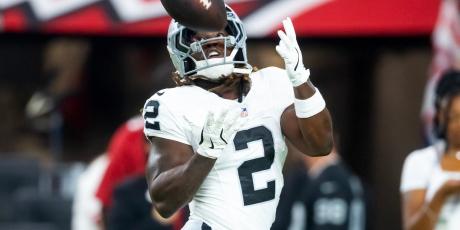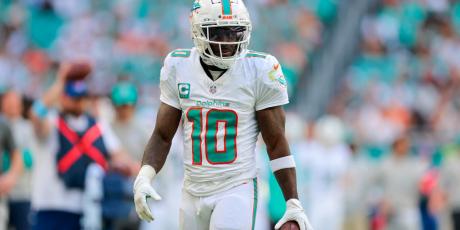How DeAndre Hopkins to the Cardinals Impacts Fantasy Football

On March 16, the Texans traded DeAndre Hopkins and a fourth-round pick to the Cardinals for David Johnson, a 2020 second-round pick and a 2021 fourth-rounder. Hopkins is one of the top wide receiver talents in the league, exceeding 1,100 yards in five of his last six seasons and always among league-leaders in target share.
The following will explore how the trade alters the passing games for both offenses and how those changes will influence fantasy football.
How DeAndre Hopkins’ Arrival Impacts the Cardinals
Going into the 2019 season, the Cardinals were one of the most talked-about offenses in the league—first-year head coach Kliff Kingsbury was bringing his Air Raid offense to Arizona, which would be led by rookie sensation Kyler Murray. Kingsbury and Co.certainly spread defenses out, running a third of their plays out of 4WR sets. No other team rolled out four receivers on more than 9% of plays and the league average for 4WR sets for every team besides the Cardinals was 1.7%.
This, however, didn’t translate to insane passing numbers—Arizona’s 60.4% pass rate in neutral game script was the 16th highest and 17 teams attempted more passes. The Cardinals did improve from 20.6 yards per drive in 2018 (last in the league) to 30.6 yards per drive last season (19th). With a year under their belts, Kingsbury and Murray should lead an even more efficient offense in 2020 and a possible second-year leap could mean more volume for Murray and his pass-catchers.
Murray’s leading receivers, Larry Fitzgerald and Christian Kirk, finished the season with 109 and 108 targets, respectively, both accounting for roughly 20% of Arizona’s target share but Kirk played only 13 games, putting him on a 133-target pace over 16 games. End-of-season targets are where the similarities end. Kirk ended the season with an average target depth of 10.0 yards compared to a 7.9-yard average depth of target (aDOT) for Fitz—29 targets of 15+ yards went to Kirk and 20 went to Fitzgerald. A more glaring difference is how Kingsbury used his two primary receivers. Consider where both players were lined up for each of their targets last season.
| Player | Left Wide % | Left Slot % | Right Wide % | Right Slot % | Left % | Right % | Slot % |
|---|---|---|---|---|---|---|---|
| Larry Fitzgerald | 7.4% | 40.7% | 5.6% | 42.6% | 48.1% | 48.1% | 83.3% |
| Christian Kirk | 6.6% | 9.4% | 38.7% | 34.0% | 16.0% | 72.6% | 43.4% |
Data courtesy of SportsInfoSolutions
Kirk’s targets came almost exclusively on the right side of the formation but he was utilized almost as much in the slot as he was on the outside. Fitzgerald worked primarily out of the slot but lined up on both sides of the ball. The question that fantasy owners must answer is how the alpha Hopkins will disrupt target shares in Arizona, assuming that Hopkins continues his massive target share.
To begin to answer that question, here’s a breakdown of how Hopkins was used last season in Houston.
| Player | Left Wide % | Left Slot % | Right Wide % | Right Slot % | Left % | Right % | Slot % |
|---|---|---|---|---|---|---|---|
| DeAndre Hopkins | 28.9% | 30.2% | 17.4% | 20.8% | 59.1% | 38.3% | 51.0% |
Data courtesy of SportsInfoSolutions
Hopkins is a unique talent in that he can and does line up everywhere on the field—his ability to exploit specific weaknesses in a defense should keep Nuk near the top of the list in target share. Given his work lined up both inside and wide, it shouldn’t be a surprise that Hopkins occupies similar areas of the field as Kirk—his 2019 aDOT was only 0.5 yards higher than Kirk’s and 26% of Hopkins’s targets were 15 or more yards downfield, compared to 27% for Kirk.
With Fitz relegated to work on the inside, three-wide receiver sets figure to have Hopkins and Kirk lined up outside while rotating through the formation in four-receiver sets.
Having a stud receiver such as Hopkins show up in town will certainly cut into one of Kirk’s or Fitgerald’s target shares, if not both. Using Arizona’s 529 attempts from last season as a baseline, the matrix below shows target volume for various target shares.
| 525 | 550 | 575 | 600 | |
|---|---|---|---|---|
| 15% | 78.8 | 82.5 | 86.3 | 90.0 |
| 20% | 105.0 | 110.0 | 115.0 | 120.0 |
| 25% | 131.3 | 137.5 | 143.8 | 150.0 |
| 30% | 157.5 | 165.0 | 172.5 | 180.0 |
x-axis: Team Targets, y-axis: Target Share
With Kirk’s ability to play inside and outside, as well as being an ascending, young player while Fitzgerald is limited to the slot with a steady decline in targets in recent years, Fitz is likely the player hurt most in this deal, though all three could reasonably hit 90–100 targets if Arizona ramps up the passing volume.
As for Hopkins, he has proven to be virtually quarterback-proof and Murray shouldn’t be that much of a drop-off from Watson, especially in Kingsbury’s creative offense. In fact, Murray is likely the big winner here. He finished as the QB7 in fantasy last season and will be valued as a top-five player at his position in 2020 drafts.
How DeAndre Hopkins’s Departure Impacts the Texans
UPDATE: On April 9, the Texans traded the 57th pick in the 2020 draft for Brandin Cooks and a 2022 fourth-round pick. Cooks has been a WR1 before and instantly leaps Will Fuller on the depth chart. Concussions have kept Cooks off the field in recent years and his production fell off a cliff in 2019. Cooks and Fuller should both be available in the WR4 range in redraft and best-ball but neither has been able to stay on the field. If one can stay healthy all season, he will have WR2 upside. DeShaun Watson's value is now only slightly downgraded after losing DeAndre Hopkins.
Besides Hopkins being one of the elite receiving talents in the league, his departure from Houston leaves 150 targets, or 29% of team targets, up for grabs. No other player on the Texans accounted for more than 14% of the target share last year. The remaining top receivers, Will Fuller and Kenny Stills, aren’t guaranteed huge bumps in volume, however, as Houston received David Johnson in the trade—one of the better pass-catching backs in the league—and signed free agent wide receiver Randall Cobb, who is coming off an 83-target season in Dallas.
Editor’s Note: Read this breakdown of David Johnson's fantasy value in Houston.
Additionally, running back Duke Johnson, who accounted for 12% of targets will still be a factor as will tight ends Jordan Akins and Darren Fells, who combined for nearly 20% of Houston’s targets in 2019.
Fuller is the favorite to get the biggest fantasy boost in Houston—his 6.5 targets per game last season put him on a 103-target pace over 16 games and 120+ targets is a reasonable expectation if he can stay healthy. That’s a huge if. Fuller has never played more than 14 games in a season and over the last three seasons, he has missed 20 regular-season games.
With that said, his upside is undeniable. Since entering the league in 2016, he is one of 14 qualifying receivers (min. 100 targets) who averages over 8.5 yards per target with a touchdown rate above 6%. If Fuller can maintain his career rates over a full season, a top-20 finish in half-PPR leagues is well within his range of outcomes but his injury risk should push his draft-day value to WR3 status. Since the trade, Fuller’s price in best-ball leagues has jumped from WR47 to WR34, which makes him available in the seventh to eighth rounds. That valuation still factors in his injury risk and leaves room for upside.
The only other relevant fantasy commodity in the passing game is DeShaun Watson. His value certainly takes a hit without Hopkins but even on passes where Watson wasn’t targeting Hopkins last season, the Texans quarterback averaged 8.09 yards per attempt and a 5.7% touchdown rate, numbers that would have ranked eighth and seventh, respectively, in 2019. Of course, Hopkins’s presence alone factors into the ability to throw to other receivers.
Given how efficient Watson has been as a passer since entering the league and his ability to add yardage on the ground, he still figures to be a top-end fantasy option at quarterback. This trade takes Watson out of the discussion as a top-three option and moves him just outside the top five, behind Murray and Dak Prescott.
The Bottom Line
The biggest beneficiary in the DeAndre Hopkins trade is Kyler Murray. Coming off of a solid rookie campaign, he now has one of the better wide receiver trios in the league in what may be the most creative offense in football. Going into his second season, Murray may be in line for a more voluminous and efficient 2020. Rostering Murray in fantasy, however, will likely cost a pick in the first four or five rounds. Hopkins is a versatile, elite receiver that will keep his status as a top-five fantasy option at his position. His presence boosts the overall prospects of Arizona’s offense and an ascending Christian Kirk could give the Cardinals two top-20 fantasy receivers while Larry Fitzgerald maintains his role as a steady but low-upside slot man.
In Houston, quarterback DeShaun Watson takes a slight hit in value but his efficiency and rushing ability should preserve his top-end fantasy ranking. Will Fuller now has high-end WR2 potential but his inability to stay on the field should keep his price in check in fantasy drafts, while Randall Cobb and Kenny Stills will be relegated to Flex options in 3WR leagues or during bye weeks.






















